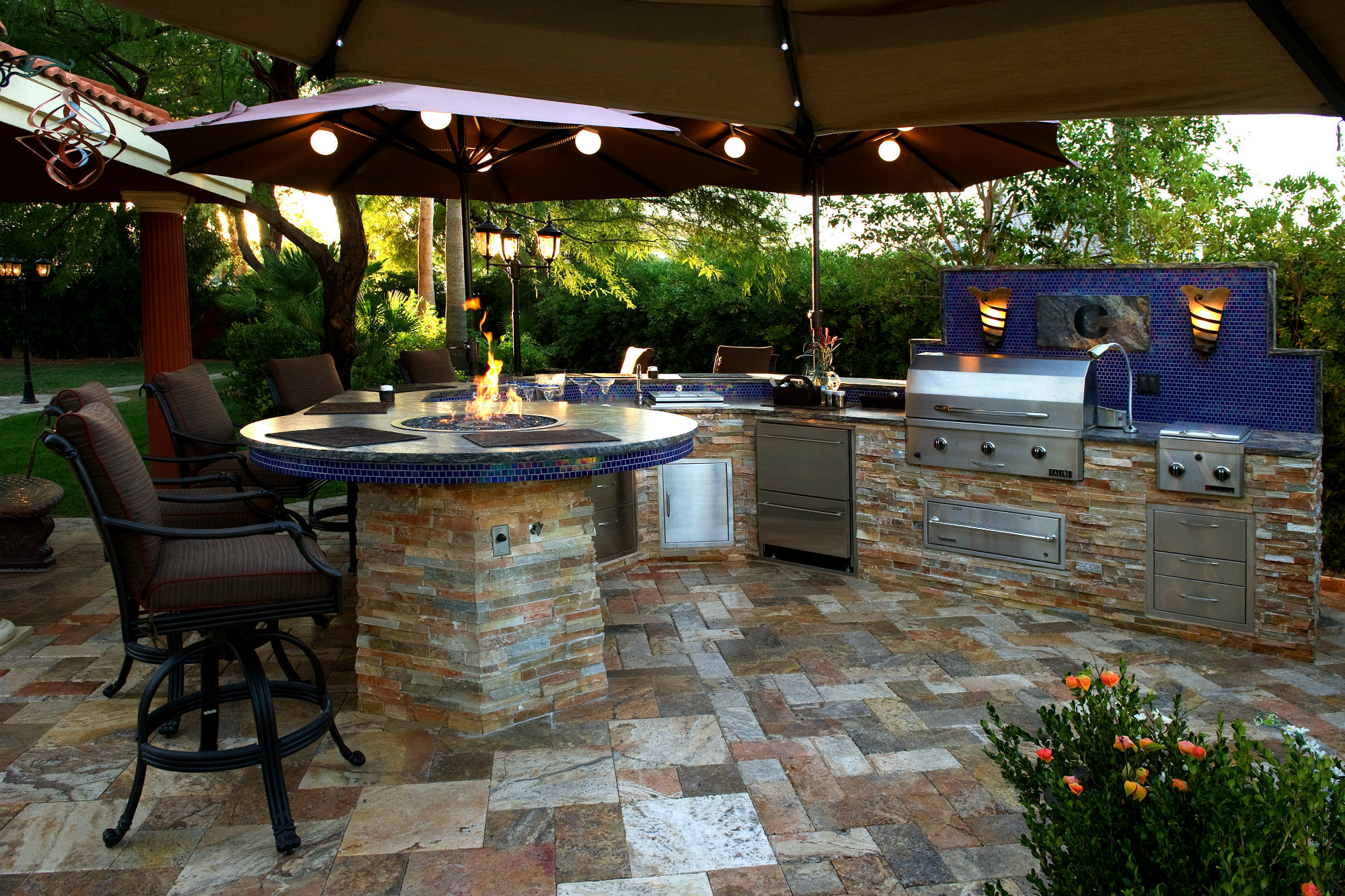The humble backyard was once thought of as a mere patch of grass and a slab of patio where the kids could run freely and parents could host the occasional family barbecue.
But my, how times have changed.
The modern backyard can easily be expected to serve as a playground, waterpark, chef’s kitchen and gourmet dining facility, as well as a meditative retreat. Since it takes plenty of supplies to turn the average backyard into a homeowner’s outdoor paradise, we’ve reached out to some of the experts to find out what consumers will be purchasing this season to make their backyard living dreams come true.
Furniture
A beautiful backyard is of little value if guests have no place to sit. That’s why consumers will be spending plenty on patio furniture this season.
Cyndi Delcher, co-owner of Pinch a Penny Pool Patio and Spa in Pensacola, Fla., has noticed a resurgence of cushioned backyard furnishings, although she says that sling furniture (non-cushioned) still has a strong fan base. And those who choose the cushion route have been leaning toward durable, comfortable fabrics, she says.
Cushion furniture customers are also using their backyard seating to add pops of bright color to their outdoor spaces, says Jessica Harkins, co-owner of TLC Outdoor Living in Katy, Texas. She reports that light blue and red are some of the most sought-after colors.
“I think people have a lot more fun with the outdoor living area because … it’s more playful,” says Harkins.
She believes that decorating an outdoor area gives consumers an opportunity to step outside the neutral color palette of their homes and be a little adventurous.
Patio furniture in bright shades of orange, green and blue also are reigning supreme at Imagine Backyard Living in Scottsdale, Ariz. In fact, the store special orders furniture for customers who are not satisfied with the brown and neutral color palettes that they find at other backyard furniture stores in the area, says David Ghiz, president/owner.
Backyards also have begun to reflect the homeowner’s dedication to the environment. Reclaimed wood is becoming a huge eco-friendly trend, and it’s popping up in items such as coffee tables, side tables and planter boxes, says Jason Larson, president of Lars Remodeling & Design in San Diego.
In addition to the eco-friendly benefits, consumers in his area gravitate toward the distressed look of the wood and are being influenced by the creations of HGTV show host Joanna Gains, who uses a lot of reclaimed wood in her projects, he says.
Grills and Kitchens
Many barbecue enthusiasts would propose that a backyard’s primary purpose is to provide enough space to grill.
And no well-dressed backyard would go without the perfect barbecue vessel. “[Grill] sales have been picking up over the past year,” says Harkins. Her store carries gas and ceramic grills as well as pellet smokers, but she’s noticed that gas grills are the most popular. They heat up much quicker than charcoal grills and the units are much easier to build into an outdoor kitchen, she says.
Aside from the basic aspects, such as price, warranty and heat conduction, Harkins’ grill customers also show interest in the little extras. Some grill brands feature an LED light that illuminates when the gas knob is turned, and her customers often request specific colors for their knobs. The most popular shade in her store is red. “It’s a small feature, [but] it’s something that people really care about,” she says.
Gas grills may be heavy hitters in Texas, but at the Backyard Barbecue Store in Wilmette, Ill., charcoal grills are in high demand — specifically smokers, says owner Dan Marguerite. He attributes charcoal’s current reign with the popularity of slow-cooked barbecue, which is done over wood or charcoal.
“[People] just love the old-school flavor of cooking over charcoal,” he says.
He also credits some of barbecue’s popularity to grilling shows on the Food Network.
Bigger also seems to be better when it comes to grills. Marguerite sells gas grills as well, and his customers want as much cooking space as they can get, because they’re preparing entire meals in the backyard. Additional features, such as sear burners, are popular as well, he says.
And those large grills are just one part of the complete outdoor kitchens that are quickly becoming a must-have feature in many backyards.
“People are asking for bigger [kitchens] with more appliances, such as [refrigerators], pizza ovens and storage,” Marguerite says.
In fact, the 2017 U.S. Houzz Landscaping Trends Survey revealed that one in 10 outdoor renovators is investing in outdoor kitchen equipment, such as a grill and either built-in cabinetry, a sink and/or a refrigerator, says Nino Sitchinava, Houzz’s principal economist who led the survey.
Ghiz attributes this outdoor kitchen phenomenon to his customers’ desire to create a complete outdoor room in the backyard — a place where homeowners can cook, eat, relax, watch TV and soak in the hot tub. “They want a space out there that’s a major extension of the home,” he says.
Imagine Backyard is also doing big business creating custom cabinets that house all of the outdoor kitchen appliances.
And what kitchen area would be complete without a proper bar? “Seated bars are always popular for the backyard,” Larson says. “[They] not only [provide] a place for everyone to hang out together, but … a place for families and friends to sit after a barbecue and share drinks.”
Shade Structures
Spring and summer make up the prime season for backyard enjoyment, but it also brings high temperatures and sunburns. That’s why consumers are investing in shade equipment and structures that not only help them beat the heat but also add a design element to the backyard.
The quickest and least expensive line of solar defense is oftentimes a simple patio umbrella. But instead of selecting run-of-the-mill umbrellas that open in the center, Harkins’ customers are requesting cantilever umbrellas. These sun shades keep those pesky poles out of the way and offer plenty of relief from UV rays. They’re also being used to create colorful backyard landscapes. TLC Outdoor Living patrons have a tendency to learn toward bold shades of red and dark blue, says Harkins.
Shade sails can offer the colorful look of an umbrella, but bring a more structured and somewhat nautical look to a backyard. These canvas covers are available in ready-made or customized shapes and sizes, and can be tensioned between trees, porches or poles to shade a specific area, says Craig Jenkins-Sutton, co-founder of Topiarius, a landscape design firm in Chicago. It’s believed the style originated in Australia to provide shade at playgrounds, parks, schools and day-care centers; the look then popped up in Florida and is just now becoming a hot trend, he says.
Shade sails are thin so they take up very little visual space, and some fabrics are translucent, which allows homeowners to watch the clouds go by as they relax in their backyards, Jenkins-Sutton says. But they are not for penny pinchers.
“When attachment points are easily available, the ambitious DIY-er can handle the installation,” says Jenkins-Sutton. “However, when attachment points need to be calculated or constructed, a professional is required. A typical backyard patio will start at $4,500 and will increase, depending on size, complexity and attachment points.”
Customers also are stepping up their backyard game with pergolas. These structures create shade but offer a look that a simple umbrella just can’t provide. Ghiz reports that homeowners are choosing alumawood for these structures, which is aluminum that looks like wood. The material is lightweight and easy to maintain, as it does not require staining, he says.
But the ultimate hide-from-the-sun method is to simply build out the roof. Consumers are attaching shingled structures to their homes that can sometimes run the length of the house, Harkins says. They provide shade while adding value to the house, she adds.
Lighting and Accessories
Now that phones have been labeled “smart,” lighting fixtures were beginning to feel left out of the loop.
The 2017 U.S. Houzz Landscaping Trends Study found that nearly half of outdoor-renovating homeowners are updating lighting, and most are choosing LEDs. And one in five homeowners are choosing “smart” lighting that can be controlled via a mobile device or computer, Sitchinava says. Last year’s U.S. Houzz Smart Home Trends Study found that reducing energy consumption was the top motivation for upgrading to smart lighting devices. Other incentives include flexibility in monitoring and crime prevention, she says.
Homeowners put an awful lot of time, energy and money into creating the perfect backyard, so it’s no surprise that they’re willing to go to great lengths to get as much use out of that space as possible.
Marguerite has been selling plenty of electric heaters to consumers who want to make use of their outdoor living area when temperatures start to descend. Ghiz, on the other hand, has seen an uptick in sales of outdoor cooling systems. His business specializes in systems that combine misters with fans that can drop the temperature of an area by 25-30 degrees, he says.
“When it gets to be 110 [degrees] here, they still want to use the outdoor space that they designed and built,” he says. “It turns that space into a year-round usable area.”



